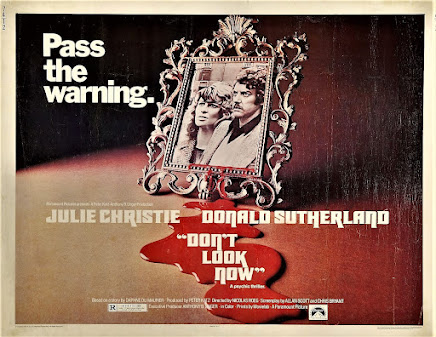 |
| A lovestruck Jane Fonda leaves her mark on a photo of lanky basketball star Anthony Perkins to publicize her film debut in Tall Story (1960) |
There really ought to have been a special Academy Award category devoted to the creative artists behind the Classic Hollywood studio publicity still. Tasked with capturing the essence of an entire motion picture via a single photographic image, the resourceful, creative, obviously twisted minds responsible for these memorably dynamic, sometimes downright weird publicity photoshoots were the unsung geniuses of movie marketing. The overlooked masters of visual shorthand.
Unlike traditional movie stills, those on-set, taken-in-the-process-of-filming production photos displayed in movie theater lobbies depicting movie scenes from vantage points approximating the cinematographer's POV—the Hollywood publicity still shares no such allegiance to reality.
 |
| This bafflingly cheery publicity still for the noirish melodrama Sunset Blvd (1950) suggests that perhaps Betty Schaefer (Nancy Olson) did indeed wind up joining fiance Artie in rainy Arizona. |
Used as flexible, all-purpose tools of movie marketing and promotion (poster art, press books, programs, sheet music, fan magazines, newspaper blurbs) publicity stills can be anything from glamour merchandising to conceptual flights of fancy. The scope of what a publicity still could be was so broad, there didn't appear to be many rules that had to be adhered to. So long as cast members were dressed in character, it seemed the sky was the limit as to what the photo itself could be. Art and commerce collide in images that run the gamut from cheesecake to cheesy. Whether utilizing posed tableaus to recreate dramatic sequences from a film, or as stylized evocations of exploitable narrative themes, at their best, they stimulate interest by honing in on the essence of a movie. At their worst (i.e., most fun) they are kitschy, laughably misguided headscratchers capable of achieving almost surreal levels of overwrought theatrical intensity.
And the world's all the better for it.
Here are a few of my favorites:
 |
| Double Trouble |
 |
| Joan Crawford, about to get all up in that ax in the thriller Strait-Jacket (1950) |
One of the oldest and most enduring of the standard movie publicity poses is the "dramatic clinch" shot. Here ratcheting up the sex and suspense while eyeing an unseen menace are (l. to r.): Robert Montgomery and Audrey Totter in Lady in the Lake (1947), John Saxon and Sandra Dee in Portrait in Black (1960), and mononymous ice-skating star Belita and Barry Sullivan in Suspense (1946).
 |
| Why, I oughtta... |
 |
| Standing in the Shadows |
This publicity still for the overheated "sweat & sweet-tea" domestic melodrama Hot Spell (1958) is pretty much on the nose in capturing what this movie is all about. It's a safe bet that whatever is suggested to you by this image of an anguished Anthony Quinn and solicitous Shirley Booth...is exactly what you're going to get.
 |
| "We're all in our private traps." |
 |
| There's Something About an Empty Chair |
In a welcome change of pace, comedy pair Dean Martin and Jerry Lewis are the ones quivering and quaking as they seek shelter behind lovely Lizabeth Scott in Scared Stiff (1953)
 |
| Ain't We Got Fun |
 |
| No, not here |
Something about this picture of Wendell Corey and Joan Crawford for Harriet Craig (1950) feels a little off (her head position and body placement look all wonky). Otherwise, it's a classic, standard publicity pose signifying romantic melodrama.
 |
| Peek-A-Boo |
 |
| Hip Huggers |
 |
| Unhand me, you brute |
Burl Ives tries to reason with Tony Perkins in Desire Under the Elms (1958)
If ever there was a woman who could get a guy to simultaneously lose his pith helmet and throw his chukka boots in the air, it's leggy Paula Prentiss. In this top favorite publicity still, six foot five Jim Hutton willingly succumbs to Prentiss' five foot ten charms to promote Where the Boys Are (1960).
 |
| Two Triangles Make a Parallelogram |
Jim Hutton and Jane Fonda again, this time appearing in what might be looked upon as the perfect, quintessential movie publicity still. It does everything a marketing movie still is supposed to do. From the costuming, poses, props, and actors' expressions, you don't have to know anything about Tennessee Williams' Period of Adjustment (1962) to look at this photo and instantly know everything. One image says it all.
D. Kucharski submitted this odd Daddy Dearest-style publicity still of Spencer Tracy looking a little too into spanking Elizabeth Taylor for the Vincente Minnelli comedy Father of the Bride (1950).
Blogger Poseidon submitted this Grand Hotel-style publicity still for The Poseidon Adventure (1972). A leg-centric, all-star cast grouping that serves up 3 variations on the "dramatic clinch" pose. As with all the photos on this blog, you can click on them to enlarge. That way you can get a better look at Carol Lynley (ironically, the film's most hysterical character) failing to get into the spirit of things by joining her castmates in looking fearful. Then there's Eric Shea forgetting that his life is supposed to be in peril and presenting his best "grade school picture day" smile. And at the top, like the star on a Christmas tree, we have Gene Hackman's unfortunate male bouffant.
L. Puck submitted this pic of Barbara Stanwyck snarling and literally dressed to kill (or at the very least disfigure) for the western The Furies (1950).




































